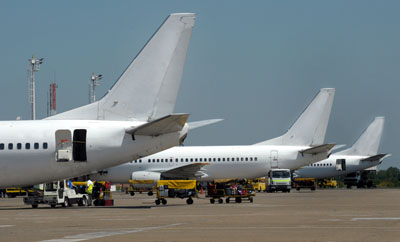 Modern OEMs are not what they used to be just several decades ago, as today they aren‘t limiting their activities to aircraft manufacturing only. As new technologies are increasingly introduced into the aviation, in recent years its players have seen the manufacturers exert more influence not only in engine, but also in airframe aftermarket processes. As a result, some MRO providers and airlines increasingly fear this will lead to less choice and higher costs.
Modern OEMs are not what they used to be just several decades ago, as today they aren‘t limiting their activities to aircraft manufacturing only. As new technologies are increasingly introduced into the aviation, in recent years its players have seen the manufacturers exert more influence not only in engine, but also in airframe aftermarket processes. As a result, some MRO providers and airlines increasingly fear this will lead to less choice and higher costs.
With the annual value of the aircraft MRO expected market to top $83 billion in less than 10 years, no wonder manufacturers are increasingly interested in benefitting from the aftermarket’s potential. However, while they surely can guarantee quality and timely services, the trend may eventually lead to the downgrade of the aircraft aftermarket‘s competitiveness as OEMs tend to dictate their rules to other market players too aggressively.
Independent aftermarket providers have already started to feel the squeeze. According to a recent Canaccord survey, over 60% of third-party MRO providers feel that OEM competition is increasing. Moreover, respondents state these dynamics have gradually reduced opportunities for airlines to find cost-competitive maintenance and spare parts support following aircraft delivery, where MROs and OEMs once fiercely competed. As a result, many independents have been left with a diminishing share of work tied to maturing fleets, not dominated by OEMs. In the meantime, however this market may already be endangered as well.
For instance, Boeing, although a considerably young entrant in the aftermarket, is already considered to be its third largest player after GE and Lufthansa Technik. Nevertheless, the manufacturer currently supports only 15% of its fleet. Thus, there are reasons to believe that the OEM is getting more direct in trying to capture a larger piece of the pie, setting limits on the price increases suppliers can pass onto the aftermarket. For instance, if in the past spares often sold for as much as three times more expensive they have in the OEM supply chain, now Boeing may be looking to limit the escalations to twice the price.
According to Zilvinas Sadauskas, the CEO of Locatory.com, while bigger MROs have the resources and the potential to co-exist with the growing OEMs’ appetite, the on-going  market developments are likely to cut the possibilities for independent development of smaller MRO providers thus potentially placing the industry’s inner-competition at risk. However, it is worth mentioning that the prospects of the OEMs’ expansion may not be as gloomy as it may seem. “MROs are still well positioned to address such strategies as reducing inventory levels, developing serviceable material programs and alternative repairs to reduce part replacement costs. In each of these, OEMs are fundamentally motivated to oppose these options, as each reduces demand for new parts, which carry robust margins for manufacturers,” the executive states.
market developments are likely to cut the possibilities for independent development of smaller MRO providers thus potentially placing the industry’s inner-competition at risk. However, it is worth mentioning that the prospects of the OEMs’ expansion may not be as gloomy as it may seem. “MROs are still well positioned to address such strategies as reducing inventory levels, developing serviceable material programs and alternative repairs to reduce part replacement costs. In each of these, OEMs are fundamentally motivated to oppose these options, as each reduces demand for new parts, which carry robust margins for manufacturers,” the executive states.
“Encouragingly, airlines want a more robust maintenance market that includes MROs in a meaningful way. This is especially relevant, as many operators are seeking ways to cut costs by seeking alternatives to buying new spares from the manufacturers. While these are still pretty expensive – even for the more mature aircraft types – they also tend to have long lead-times and import delays, which is unaffordable in case of an AOG,” shares the CEO of Locatory.com. “Meanwhile, currently there is an excess of surplus materials in the market, most of which comes from the consumables, acquired by the MROs for C-checks in large quantities. However, the providers actually use only 50-80% of these parts, while the rest of them remain in their storages, so utilizing the surplus by selling is a viable strategy for many of them. Moreover, while the OEMs are in a good position to tie their clients with long-term support contracts, they usually don’t have supply networks that are wide enough. Meanwhile, as logistics account for a major share of the airline’s expenses, partnering with third-party providers might solve the issue in a mutually-beneficial way. Therefore, if independent MROs will manage to hone and expand these capabilities, they may yet successfully stem OEM momentum and defend their remaining market.”





